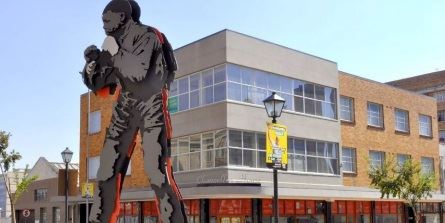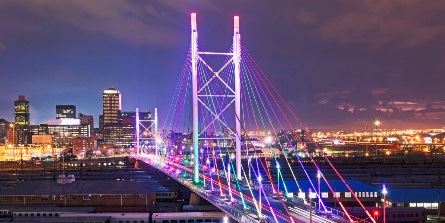This year marks the centenary of the birth of Nelson Mandela and the country is celebrating it throughout the year. Tourists can look forward to learning about the great man and Johannesburg provides a number of ways to do so. Tourism Update rounds up the key sites in and around Johannesburg to visit:
Mandela House, Soweto
Situated on Vilakazi Street – famous for being the only street in the world to have housed two Nobel Peace Prize laureates – is the house that Nelson Mandela shared with his first wife, Evelyn Mase, and later his second wife, Winnie Madikizela Mandela. Mandela lived at the house with his family from 1946 to 1961 when he went into hiding. Winnie remained in the house until 1977 until her banishment to Brandfort in the Free State. The house has been restored to reflect their lives and is home to a number of artefacts related to the Mandela family.
Evelyn Patrick, Operations Manager at Snappy Coach Hire says: “A Soweto tour is still the best way to learn about Mandela; people love his home and Vilakazi Street. That said, there seems to be more interest from the older generation than younger tourists.”
Mandela House is open daily from 09h00 to 16h45 and costs R60 per adult (€4).

Liliesleaf Farm, Rivonia
Following the banning of the African National Congress in 1960, a number of key leaders of the movement were forced underground into hiding. The farm called Liliesleaf was purchased by the South African Communist Party through a shell company and became the secret headquarters of the ANC. Mandela moved there in 1961 and assumed the alias David Motsamayi. Liliesleaf became the location of the ANC’s strategy meetings and was where a number of potential attacks on the apartheid state were planned. In 1963, following months of observation, the farm was raided by apartheid security police. A number of incriminating documents were found that led the state to charge key ANC members with sabotage and treason, including Mandela. The Rivonia trial began in December 1963 and eventually led to Mandela being sentenced to life imprisonment on Robben Island.
Patrick recommends this for tourists saying: “Liliesleaf is an underrated sight.”
The farm has been preserved and turned into a museum. It is open daily from 08h30 to 17h00 with an entrance fee of R110 (€7) for a guided tour.

Chancellor House, Ferreirasdorp
When Mandela moved to Johannesburg from the Eastern Cape, he set up a law firm with his friend Oliver Tambo. Their firm – Tambo Mandela Attorneys – was housed in Chancellor House, directly opposite the Johannesburg Magistrate’s Court. The building has since been preserved and an outdoor museum, visible from the street, erected explaining the pair’s work as black lawyers under apartheid and their impact on the city and the movement against apartheid.

Constitution Hill, Braamfontein
Home to the country’s most powerful court, the Constitutional Court, Constitution Hill is built on the site of a colonial-era prison and fort. Officially opened in 1893, the prison was used as a fort during the Anglo-Boer War before it was turned back into a prison, housing a number of key historic figures, including Mahatma Gandhi and Mandela. The site today is home to a museum, interpretive centre and the Constitutional Court. The museum has a section dedicated to Mandela and Gandhi, unpacking the parallels between their lives. On days when the court is not in session, visitors are able to view the court along with the museum.
Children are also catered for at Constitution Hill with a kids’ museum called Play Africa. Play Africa is based inside the Old Fort section of the precinct, just 20 metres from the former cell where Nelson Mandela was once incarcerated. According to Gretchen Wilson-Prangley, CEO at Play Africa: “The location is particularly significant this year as 2018 marks the centenary of the birth of Nelson Mandela. This anniversary provides a unique opportunity to reflect on his life and times and to promote his legacy through collaborations with local partners that promote democracy and human rights.”
Constitution Hill is open daily from 09h00 to 17h00 at a cost of R60 (€4) per adult or R100 (€6) for a full guided tour.
Top tip: If you visit the court on a day when court is in session, the public can sit in on a session and watch court proceedings. Just bow to the Chief Justice when you enter and leave the gallery.

Apartheid Museum, Ormonde
A staple for any visit to Johannesburg, this museum features in-depth analysis of the history of South Africa as well as a separate exhibition covering Mandela’s life. Featuring a display of his writings and even the car made for him after his release from prison, this exhibit is an excellent way for tourists to learn all about his life.
The Apartheid Museum is open daily from 09h00 to 17h00 at a cost of R95 (€6). Guided tours are also available and can be booked in advance.

Nelson Mandela Square, Sandton
Home to a number of restaurants and shops, Nelson Mandela Square is located in Sandton City and home to a larger-than-life statue of Mandela and a newly opened outdoor installation. The new addition, installed by photographer and artist Erhardt Thiel, includes a replica of the bench Mandela had in his cell on Robben Island. The Square also commissioned a ‘100’ logo installation, along the same lines as the ‘LOVE’ installation in New York City. Using the official centenary logo of the Nelson Mandela Foundation, the installation uses mirrors to symbolise reflection.

Nelson Mandela Bridge, Braamfontein
Crossing Johannesburg’s railway tracks, the bridge was opened in 2003 and has become an icon in the city. Spanning 295 metres across 42 railway tracks, the suspension bridge connects the downtown suburbs of Braamfontein and Newtown, both bustling areas filled with culture, art, music and food. It is the largest cable-stayed bridge in southern Africa. At night, the bridge is lit up with the colours of the rainbow.
Top tip: Crossing the bridge is fun but for the best view of the bridge, tourists should drive over the Queen Elizabeth Bridge or along the M1 South.

Nelson Mandela Centre of Memory, Houghton
At the location of Mandela’s last office before he retired, the building is also home to the Nelson Mandela Foundation. The permanent exhibition at the centre, The Life and Times of Nelson Mandela, uses documents from the man himself as well as other items, photographs and artefacts to illustrate his life story. A second exhibition space houses temporary exhibitions, changed two or three times a year. For the centenary year, it is showing Unthreading Madiba – an exhibition that traces Mandela’s life through he way in which he constructed his image, or, at times, the image that was constructed of him. The exhibition has chapters representing an image of Mandela through the clothes he wore or a name that he was given or took on.
The Nelson Mandela Centre of Memory is open on weekdays from 09h00 to 16h00 and is free to the public.
Top tip: Just around the corner, on 12th and 13th Avenues are the two homes where Mandela lived in Johannesburg after he moved from Soweto following his release from prison. He died at his Houghton home in December 2013.
Patrick concludes: “Mandela has left a lasting and wonderful legacy. It’s important that we encourage the youth to learn about all the good that was done and the miracle of abolishing apartheid.”























